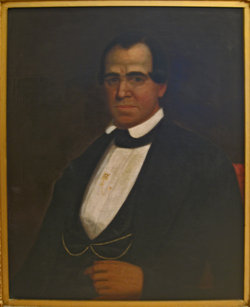Over the fall semester Hannah, Mayson and I visited and researched St. Mary's Roman Catholic Church. We found very many interesting things about this church that allows it to be original and differ from other churches around Charleston. Below you will find some of the most interesting characteristics of the church.
1. The Artistically Beautiful Interior
1. The Artistically Beautiful Interior
 |
| Above is the ceiling inside the church. |
-If you take a look on the inside of St. Mary’s, it is almost entirely covered in 23 beautiful paintings from the walls to the ceilings. Upon entering, above the unique marble altar in gold text are the words, “Hail full of grace the Lord is with thee.” The most eye catching element to the church’s magnificent interior, are the paintings on the ceiling. Sitting in the pews during a service, one can look up at the gorgeously detailed art and almost feel like they are in The Vatican.
2. The Unborn Memorial
 |
| Above is the grave of the Unborn child. |
3. Little Annie
-When strolling through the cemetery of St. Mary’s, it is crucial to pay respects to the grave of Annie Amelia, who died at just 6 months old. The statue of a resting young lamb at the top of her headstone symbolizes innocence and youth. At the bottom right corner of her grave, one can find the signature of the artist, W.T. White.
 |
| The grave of Little Annie. |
4. Stained Glass Windows
 |
| Stained glass window in the church. |
 |
| Stained glass windows in the church. |
5. The Grave of Rémy Mignot
 |
| Grave of Rémy Mignot |
6. Indoor Floor Burials
-When walking up the center aisle of the church you end up at two plaques on the floor. These plaques are two grave markers for The Reverend Claudian B. Northrop and Very Reverend Richard S. Baker. On the floor at the front of the left and right aisles in the church are two more grave markers. They both also have headstones outside in the graveyard along with the rest of the people buried there.
 |
| The two graves at the front of the church. |
7. Saint Peter's Six Toes
 |
| The painting of Saint Peter. |
 |
| A close up view of Saint Peter's six toes. |
8. Vigil Candles
 |
| Above is the Vigil candles on the right side of the altar. |
9. Rebuilding of the Church
 |
| The exterior of the new church. |
 |
| The view of the church from the balcony in the rear of the church. |
10. Interior Detailing
The interior of Saint Mary's Roman Catholic Church has paintings that date all the way back to 1814, one in particular was from the earlier brick church. This painting is located in the center of the altar and is very popular and known at the painting of the Crucifixion of Jesus Christ. Unfortunately, the painting was burned in the fire of 1838, but was able to be restored by its original Charleston artist, John S. Cogdell, after the fire.
 |
| The altar of the church. |
Here is our team picture at the church!





































